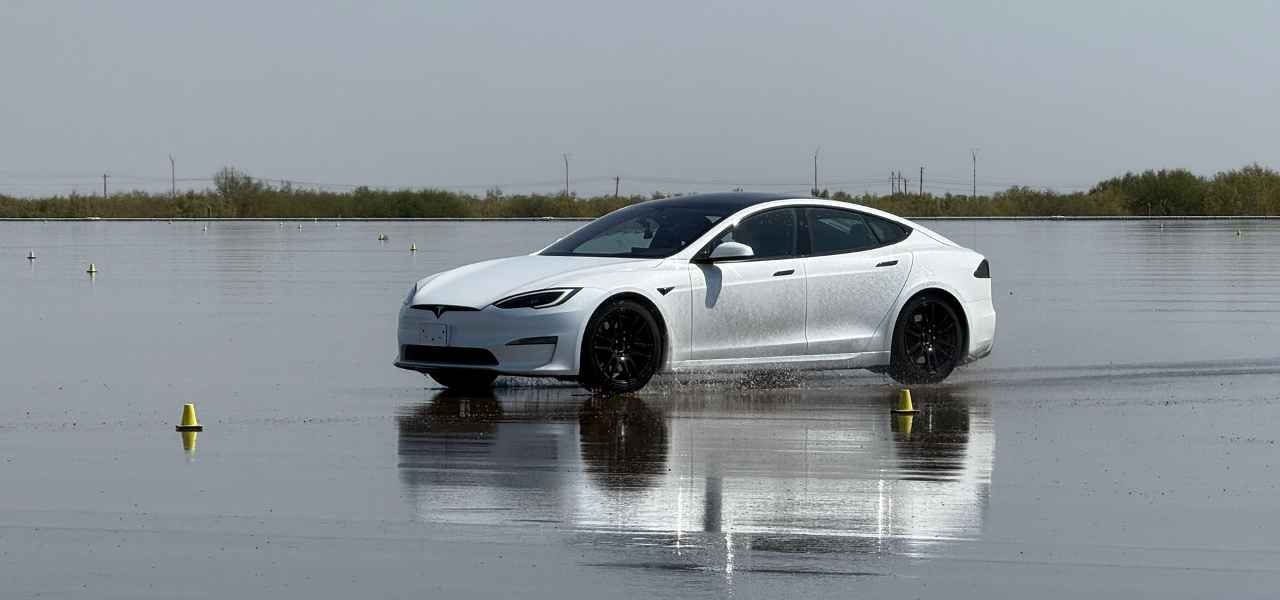 一辆特斯拉Model S正在TRC的湿滑地面车辆动力测试区域进行测试。(Sebastian Blanco)
一辆特斯拉Model S正在TRC的湿滑地面车辆动力测试区域进行测试。(Sebastian Blanco)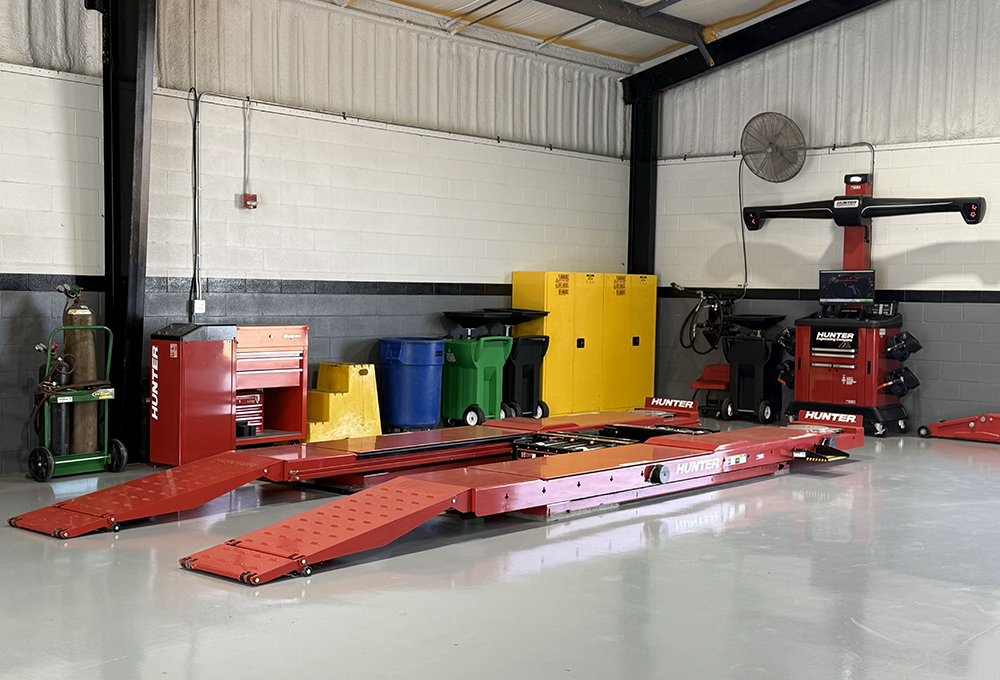 TRP维修大楼内的亨特对准升降机。(Sebastian Blanco)
TRP维修大楼内的亨特对准升降机。(Sebastian Blanco)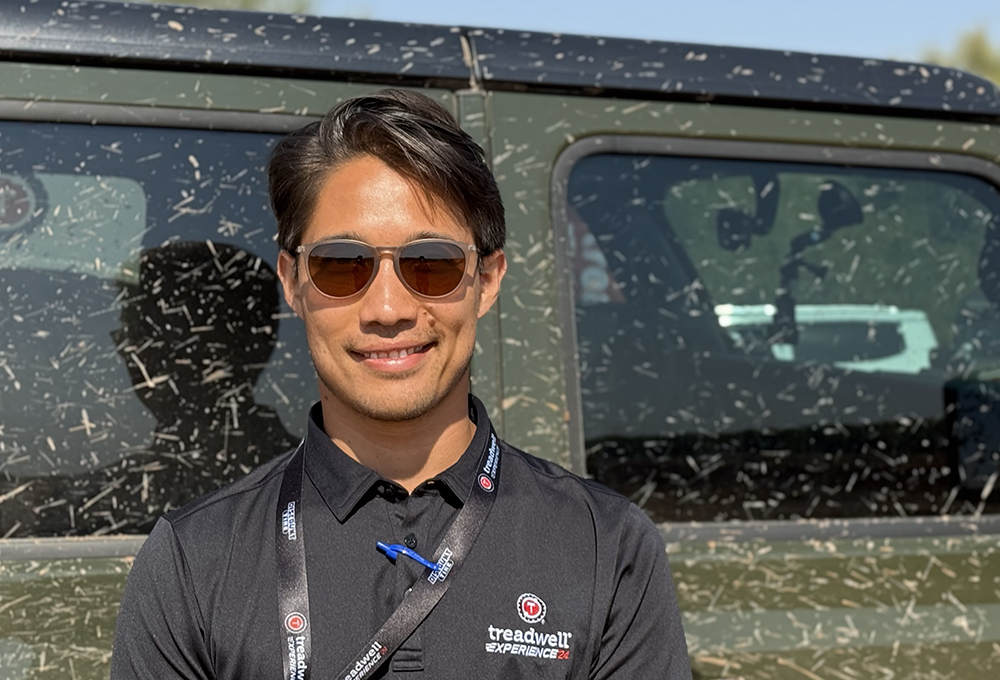 Smithers的TRP跑道系统经理Taylor Floyd(Sebastian Blanco)
Smithers的TRP跑道系统经理Taylor Floyd(Sebastian Blanco)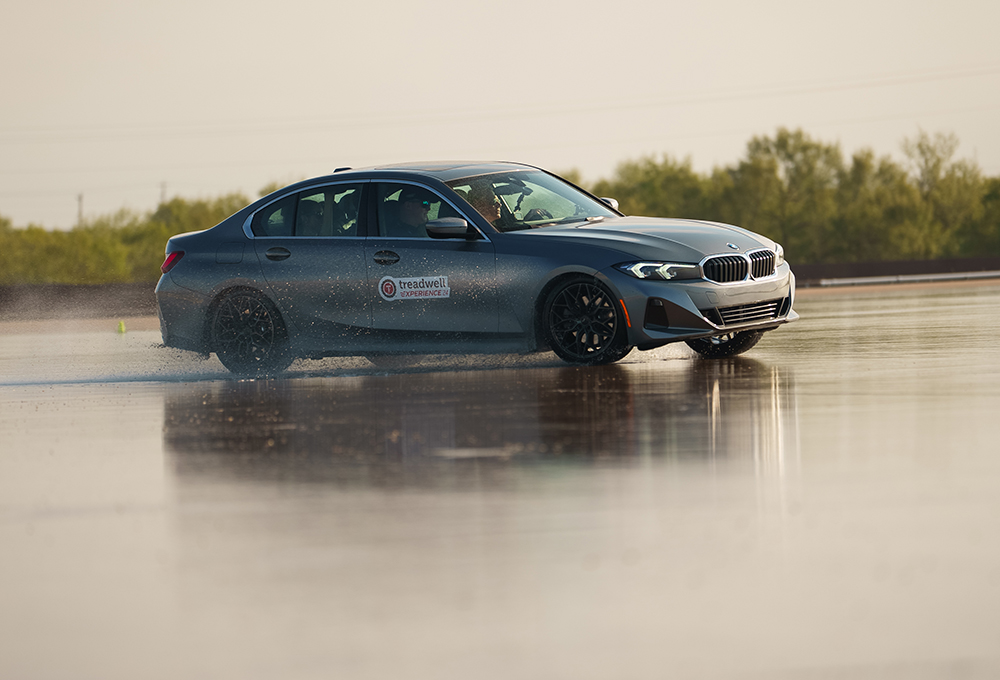 TRC的湿滑地面车辆动力测试区域是一个800*800英尺(244*244 米)的赛道,包括一个水深为1.75至2.25毫米(0.07至0.09 英寸)的公路赛道。(Discount Tire)
TRC的湿滑地面车辆动力测试区域是一个800*800英尺(244*244 米)的赛道,包括一个水深为1.75至2.25毫米(0.07至0.09 英寸)的公路赛道。(Discount Tire) TRC的越野赛道全长超过4英里(6公里),由硬土、岩石、沙子和砾石铺成,设有弯道、爬坡和其他障碍。(Discount Tire)
TRC的越野赛道全长超过4英里(6公里),由硬土、岩石、沙子和砾石铺成,设有弯道、爬坡和其他障碍。(Discount Tire)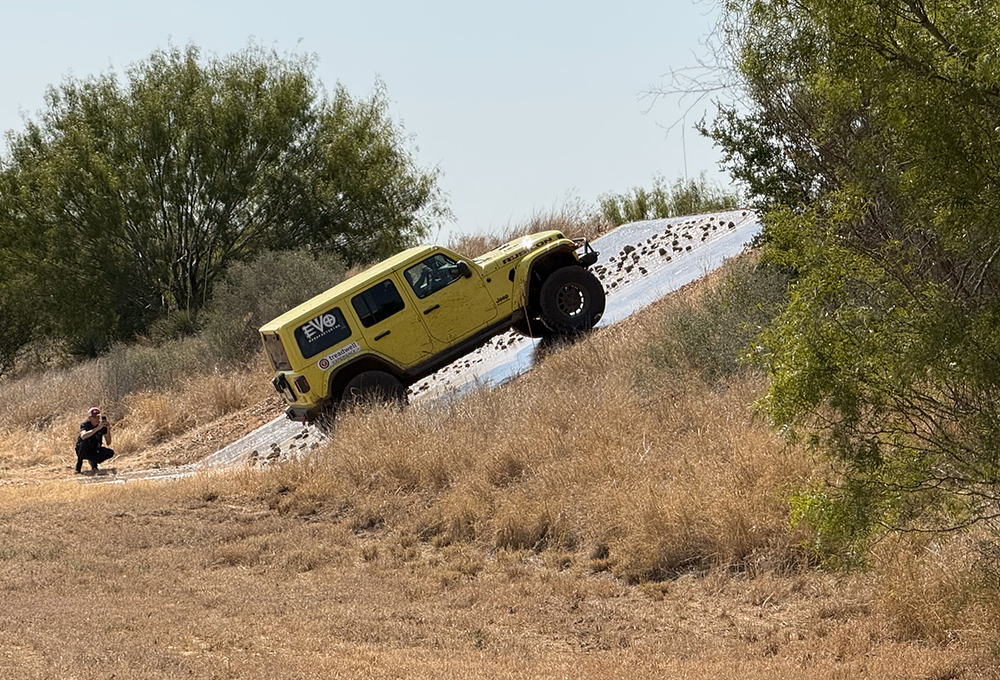 在湿滑条件下测试TRC的30度光滑混凝土斜坡。Discount Tire表示,这一特性非常适合耐久性和主观牵引力测试。(Discount Tire)
在湿滑条件下测试TRC的30度光滑混凝土斜坡。Discount Tire表示,这一特性非常适合耐久性和主观牵引力测试。(Discount Tire)
如何将轮胎测试数据转化为非工程专业人士也能理解的信息?
Discount Tire公司的首席产品与技术官John Baldwin告诉SAE,在Treadwell研究园(Treadwell Research Park)开展的所有工程工作中,有一种神奇的方法可将大量测试数据转化为非工程师也能理解的实用信息。
TRP是Discount Tire的数据生成中心,该公司的Treadwell轮胎选购指南背后的算法,使用的正是这里生成的数据。该工具采用五星制评分体系,可为轮胎选购者提供个性化且简明易懂的产品推荐,消费者可在应用程序、网站和线下门店使用该工具。Baldwin 表示,多年来,Discount Tire及其合作伙伴测试了超过2万只轮胎,涵盖500到1000种不同类型,包括衍生和升级产品。
然而,测试一款轮胎并得出其滚动阻力系数为8.2是一回事,向店里的轮胎选购者解释这一数据则是另一回事。
“应该如何告知客户,一只轮胎不错但不够出色?我们的方法是给它打三星,或是三星半的评分,”他说,“这只是借鉴了一些行业中已有的做法。我们会在后台对数据进行分级。例如,X到Y是五星,Y到Z是四星半。我们的算法使用真实数据,希望能让客户无需成为轮胎方面的专家就可理解专业信息。”
据Baldwin介绍,为了实现这一目标,本身不生产轮胎、只负责销售的Discount Tire收购了一家轮胎测试机构。这个占地900英亩的测试场地位于德克萨斯州圣安东尼奥附近,之前由Cooper Tire & Rubber公司所有,2021年被固特异轮胎收购。由于固特异在德克萨斯州已经有了一个测试跑道,Discount Tire获得了收购TRP的机会。
Discount Tire并不参与TRP的日常运营,而是雇佣轮胎测试公司Smithers作为独立第三方,每年使用该设施约120至150天。此外,一些轮胎OEM在TRP的三个附属建筑中长租了固定空间。TRP的主楼包含办公区和一个配有五个车辆升降机的车库,而附近的一座维修用楼则存放了轮胎和Matteuzzi胎面打磨机等工具。
当我们乘坐的Wrangler停留在30度坡道上时, Floyd解释道:“在测试三种不同的胶料时,我们会感受到三种不同的‘抓地感’。在进行这类测试时,我们不希望依赖动能,因为动能是一个很难控制的变量。如果尽可能缓慢且稳定地爬坡,就能使测试条件保持高度一致。我们可以把不一致的因素移除,并尽可能添加一致的因素。”
“每种胶料、每种设计在这些极小的接触面上弯曲方式都各不相同,”他说。“硅基胶料可能在胶料面的边缘处含有硅颗粒,这有助于其抓住接触表面上的微小粗糙点。胶料在轮胎边缘0.1毫米范围内的弯曲方式,是最能体现胶料性能之处。嵌在橡胶表面的硅颗粒是否足够牢固,能提供牵引力,还是会从橡胶表面滑出?胶料在开始撕裂之前能否保持自身结构?这些都是需要测试的问题。”
“从技术上讲,轮胎不可能总是全新的,”他说。“一旦上路,轮胎的磨损就马上开始了。因此,轮胎性能存在一个逐渐改变的过程。我们已经让消费者意识到,应该考虑轮胎在整个生命周期中的性能,而这是以磨损程度来衡量的。”
For all the engineering that takes place at the Treadwell Research Park (TRP), Discount Tire’s chief product and technical officer John Baldwin told SAE Media that there’s actually something akin to magic in the way giga-reams of test data are converted into information non-engineers can usefully understand.
TRP is where Discount Tire generates data used by the algorithms behind its Treadwell tire shopping guide. The consumer-facing Treadwell tool, available in an app, a website and in stores, provides tire shoppers with personalized, simple-to-understand recommendations that are mostly based on a five-star scale. Discount Tire and its partners have tested over 20,000 SKUs, representing 500 to 1000 different types of tires over the years, Baldwin said, including variants and updates. Testing a tire to discover it has an 8.2 rolling resistance coefficient is one thing. The trick is finding a way to explain it to someone standing in a tire shop.
“How do I say that that’s an okay tire but not a great tire? Three. Or three and a half,” he said. “We just latched on to what the world’s already doing. Behind the scenes, we’ll have it, in that case, bucketed. X to Y is a five-star, Y to Z is four and a half, those kind of things. The algorithm actually does take the real data. The expectation is our customers are not going to become experts on tires.”
To do that, Discount Tire - which does not manufacture tires, it just sells them - bought itself a tire testing facility. The 900-acre site near San Antonio, Texas, was previously owned by Cooper Tire & Rubber Company before it was purchased by Goodyear in 2021. Since the company already has a test track in Texas, Goodyear offered Discount Tire the opportunity to buy the TRP, Baldwin said.
Discount Tire is not involved in TRP's day-to-day operations. Instead, tire testing company Smithers acts as an independent third party that uses the facility around 120-150 days a year. Some tire OEMs – Discount Tire would not name them – rent permanent space at TRP in the three outbuildings. The main building houses offices and a garage with five vehicle lifts, while a nearby maintenance building holds stacks of tires and a Matteuzzi tire buffer, among other tools.
Test for yourself
During a recent media day, Discount Tire opened TRP to SAE Media and other outlets. We were able to participate in tests similar to what the Smithers engineers do there. That meant feeling the way Goodyear Assurance Max Life All-seasons pulled differently from Michelin Pilot Sport S summer tires around the curve of the 2-mile oval at 65 mph (105 km/h). We tested those same EVs and two BMW M5s on the 15-acre wet track with a one-degree slope and a Lotus Emira Turbo First Edition through some cones before running a Jeep Wrangler Rubicon through the off-road course. While we were stopped on the polished concrete hill, Smithers’ TRP track systems manager, Taylor Floyd, told SAE Media why this is a great way to test tire compounds.
“If you’re testing three different compounds, you’re gonna have three different ‘feels’ of how easy it is,” he said as we sat in the Wrangler angled at 30 degrees. “When you’re doing this type of testing, you don’t want the momentum because that’s already a variable that is really hard to control. If you go up there as slowly and as steadily as possible, you can be the most consistent. You can take something inconsistent and try to add whatever consistency is possible.”
The polished concrete hill test is where drivers evaluate how much throttle they can add before the vehicle starts up again if the vehicle loses traction at any corner, and if the driver needs to engage a differential lock or something similar to complete the climb. Floyd said the usual expectation is that 2WD will get the vehicle up the slope but will not be able to restart forward momentum once it comes to a complete stop. Restarting up the hill is the moment of truth. What the drivers are trying to feel with this test, he said, is how well the roughnesses of the rubber surface and the polished concrete surface play together at the tiniest of scales to either stick or slip.
“Each compound, each design is going to have a different way it flexes at that really small interaction face,” he said. “A silica-based compound may have silica pieces at the edge of the compound face, and that helps grab onto the small roughness of the surface itself. How the compound flexes in that 10th-of-a-millimeter range at the edge of the tire, that’s where the compound is having the most effect. Is the little piece of silica stuck in the rubber surface well enough to provide traction, or is it going to slip out? How is the compound holding on to itself before it starts to tear apart?”
Subjective/objective
Baldwin, a polymer scientist who previously worked at Ford, said the Smithers test drivers use the SAE J1060 10-point subjective rating test to turn feelings into numbers.
“The drivers all follow the SAE rules for that,” he said. “A difference of one means a professional driver may notice the difference, but your average driver wouldn’t. Two is normal people, and three is a huge difference, which translates into half, one and one and a half stars. Let’s say out on the wet, they might have ten categories that they’re rating. There’s the lap time, which I consider objective, but then there’s breaking, which is subjective out there, cornering, steering, response, linearity, transition, all of those things that then they’re putting ratings on. Then they add it up, and they come up with [a score] out of 10 points, and we turn that into the five stars. We might be stylizing it when we show it, but the actual number behind the scenes is whatever the driver comes up with. That’s the number we use.”
Baldwin said the automotive industry has been dealing with these sorts of subjective reviews for a century, and one of Treadwell’s solutions is the use of control tires to help drivers find the baseline each time. These are usually represented by a standard Michelin tire for the application at hand, but “it doesn’t mean they’re the best,” Baldwin said; they’re just the most consistent. These control tires are usually so reliable that Smithers’ drivers have been able to identify manufacturing problems that Discount Tire has then reported back to the tire OEM.
“We re-audit tires too,” he said, to make sure nothing’s changed. “Usually, we would know, but not always. So when we get different numbers than we did a year ago, we would call the manufacturer and go, ‘Hey, what’s up?’ What will happen is we’ll report that in Treadwell. This isn’t about history. This is about today. Someone’s buying tires today. So we want to help them make their decision. We want Treadwell to rank with what the product is today, not what it was a year ago.”
Treadwell also tests worn tires, using that Matteuzzi tire buffer with diamond-encrusted blades and other surfaces to wear them down to 4/32nds before sending them on a trailer test that’s similar to the European R117 wet testing protocol. This test requires only one buffed tire, but Baldwin said that when the engineers were developing the test, they had to correlate between the on-vehicle tires and the machine, but the results are now solid. Reliable data means Treadwell is itself reliable, Baldwin said.
“If you think about it, technically, nobody drives on new tires,” he said. “They’re wearing right away. So there’s this whole gradient of change. We’ve driven an awareness that we should be thinking about the performance of your tire through its life and its life as being defined as wear.”
等级
打分
- 2分
- 4分
- 6分
- 8分
- 10分
平均分
